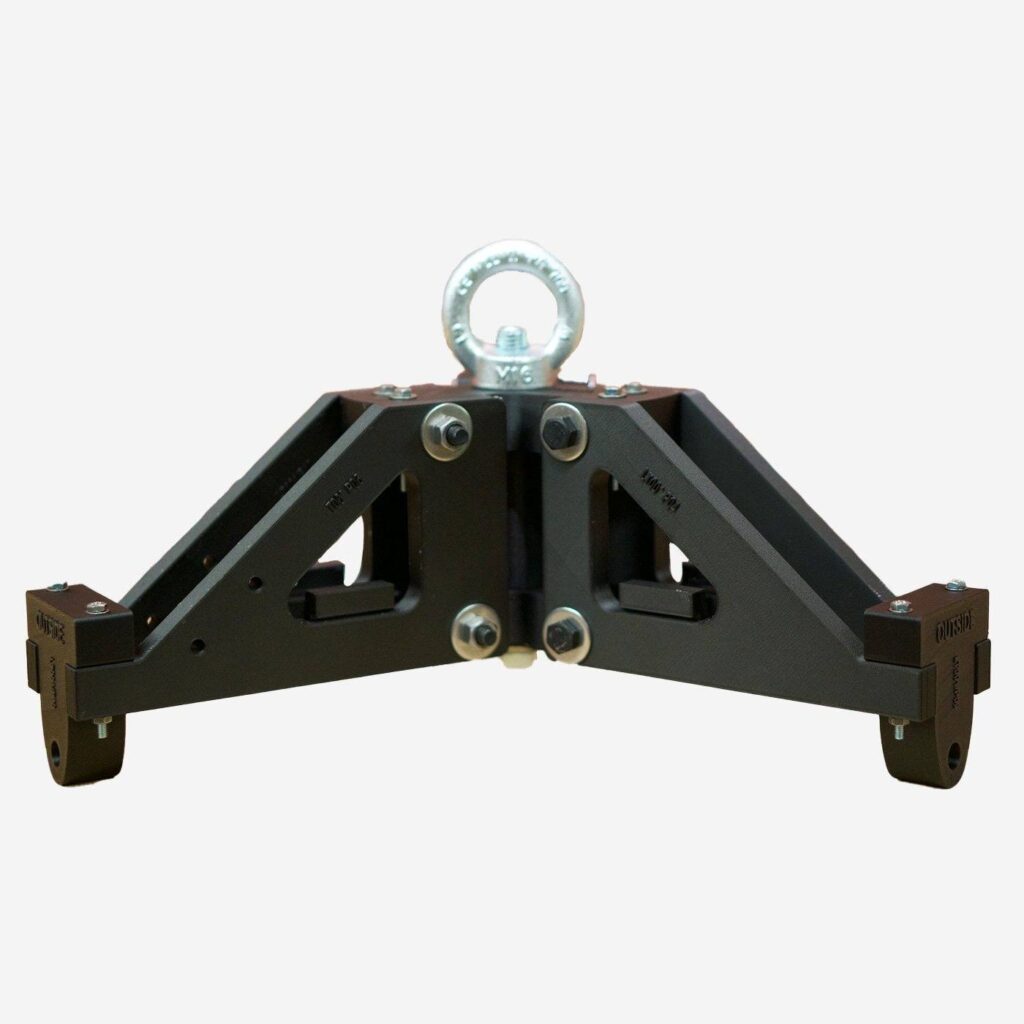
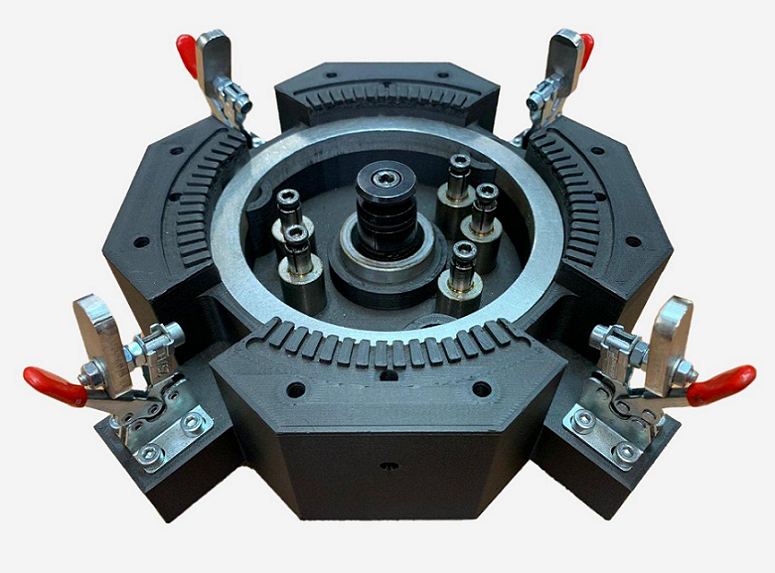
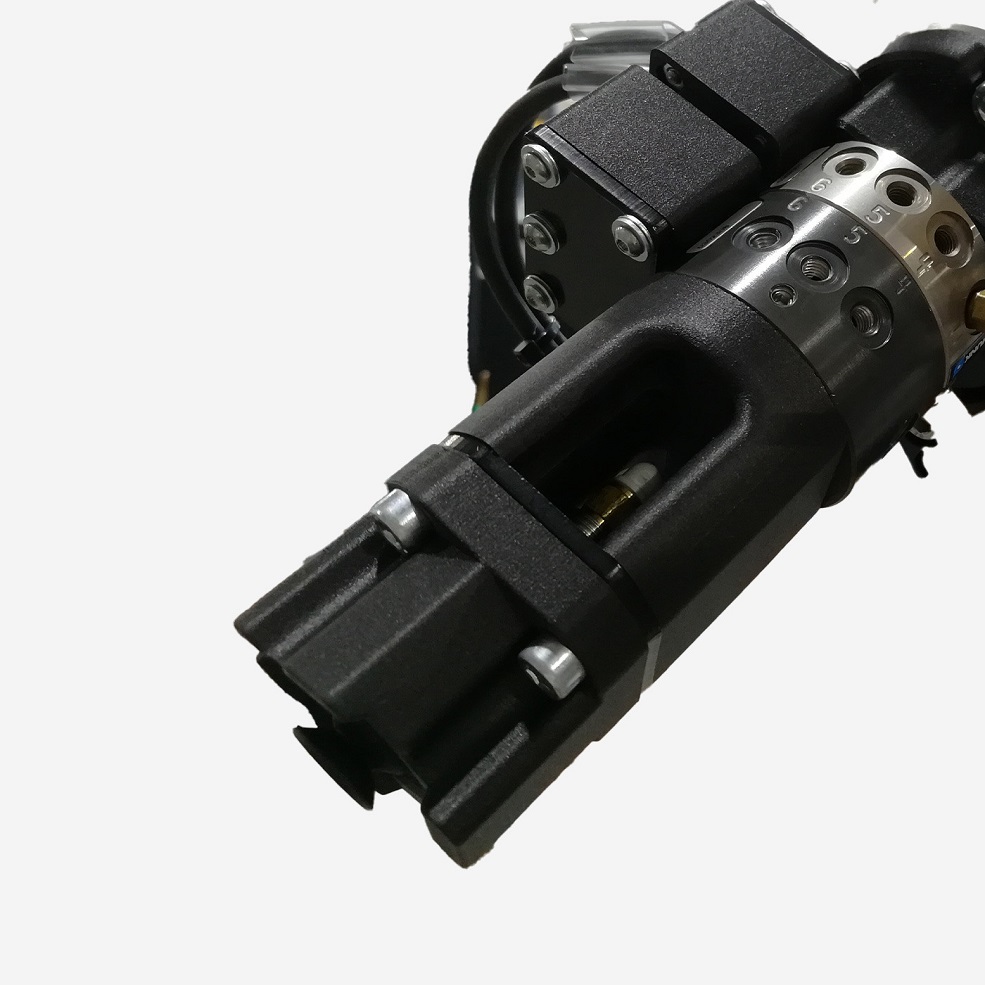
Markforged 3D Printing
From automotive and aerospace, to electronics and manufacturing, these modern manufacturers featured here are 3D printing some pretty revolutionary parts – and doing so in-house. For those new to Markforged, composite 3D printing provides the strength you need for tooling and functional parts. Their Industrial grade, large-format printers deliver exceptional accuracy, reliability and repeatability. We dive into what that looks like in this blog.
Laser Welding Fixture
– Onyx, Fiberglass
– Primetall

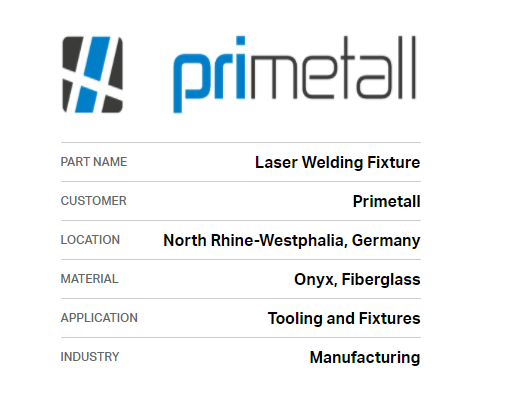
Part Summary:
These laser welding fixtures from company Primetall used to be made of stainless steel. Now, they’re 3D printed in onyx and fiberglass with Markforged technology.
They have the durability to withstand holding heavy steel parts while rotating at high speeds. Primetall’s engineers manufactured the prime to accept a zero-point clamping system, contributing to faster processing. A win-win.
Full Customer Story:
German-based Primetall offers a comprehensive range of solutions tailor-made from high-quality stainless steel. They work closely with their customers to provide the absolute best service. By bringing consulting, design, and production under the same roof, they offer shorter timelines, better service, and more know-how. Their products have a reputation for precision, quality, and durability.
The team was drawn to the Markforged platform to manufacture parts printed from and reinforced with continuous fibers. Plus, they found the hardware and software easy to learn, requiring only a minimum level of training before they were up and running. Cloud-based software like Eiger gave Primetall even more options.
These welding machine fixtures have the durability and dimensional stability to withstand the stresses of holding heavy steel parts while rotating at high speeds. Moreover, the reduced weight with onyx material and fiberglass material compared to the steel original improves the cycle time of the laser welding process. With the design flexibility afforded by Markforged 3D printers, Primetall’s engineers were able to manufacture the prime to accept a zero-point clamping system, further contributing to faster processing times. After a resounding success with the clamping fixtures, the engineers broadened the scope of composite printing to gas ducts, which are critical for clean welding.
Piston Lifting Tool
– Onyx, Carbon Fiber Reinforcement
– Wärtsilä
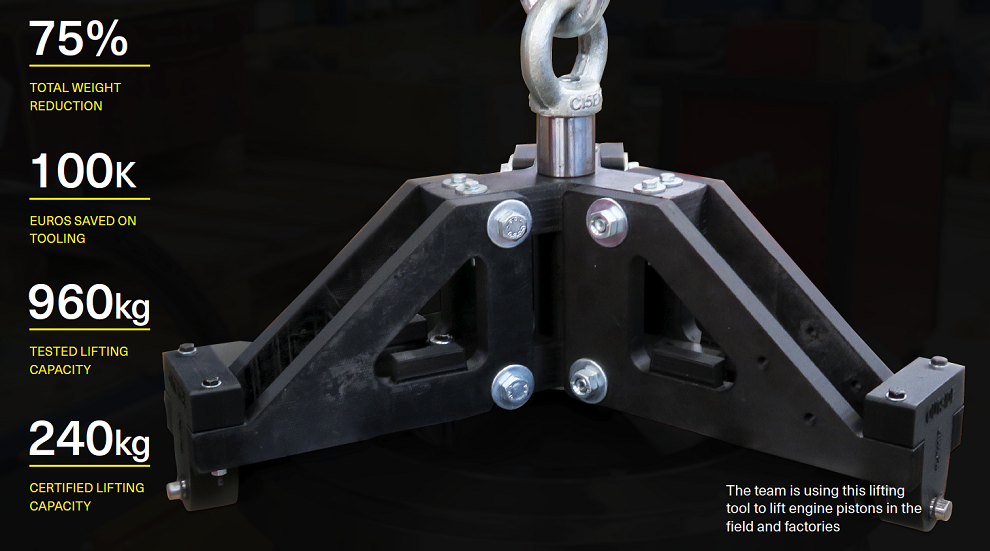
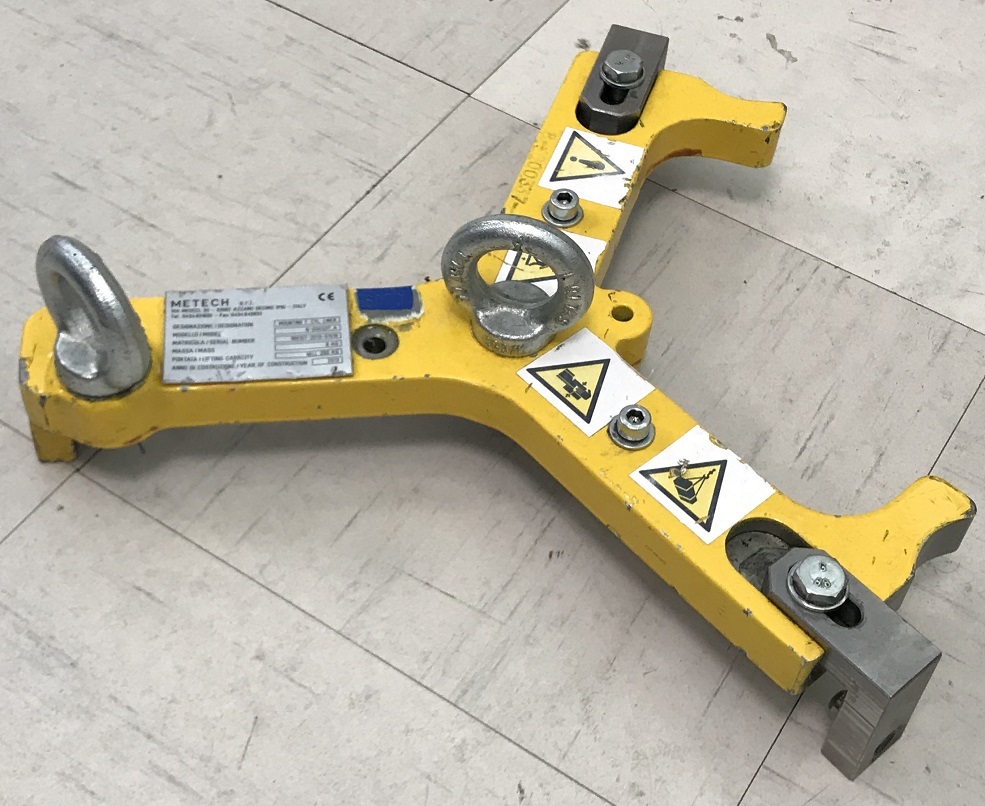

Part Summary:
Previously machining its lifting tools out of solid steel, Wärtsilä found the results too expensive, and too heavy. Working with Markforged, Wärtsilä’s engineers redesigned their lifting tool, including splitting the tool into many parts for continuous carbon fiber reinforcement and enabling it to lift a 240 kg engine piston.
The max weight the tool can lift is 960 kg. It’s also the 1st 3D printed CE-certified lifting tool.
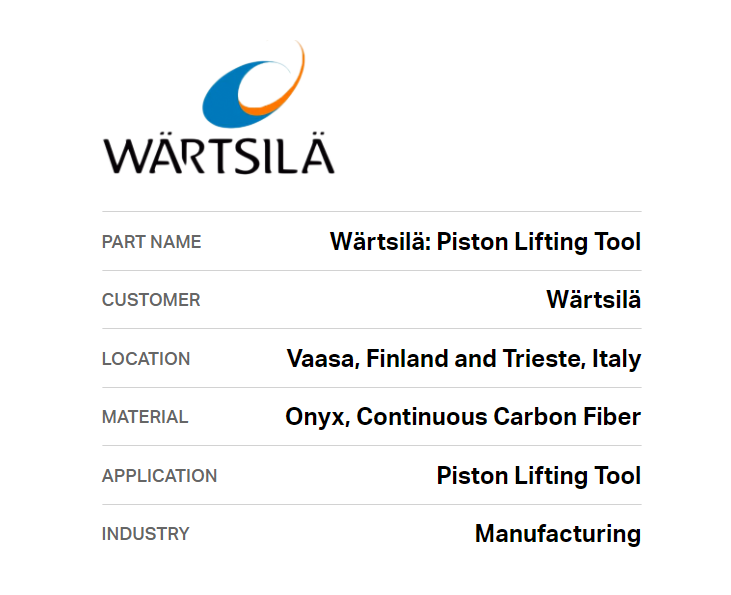
Full Customer Story:
Wärtsilä is a global leader in smart technologies and complete lifecycle solutions for the marine and energy markets, with a portfolio of products that spans from engines to propulsion and renewable solutions. The Finnish factory in Vaasa and Italian factory in Trieste oversee the manufacturing of large engines that power a third of the world’s largest cargo ships. The teams often need to fabricate tools to solve problems and optimize the efficiency of both the field and factories, and usually have to rely on third-party suppliers to manufacture them.
Wärtsilä usually machines its lifting tools out of solid steel, but found the resulting tools to be too expensive, too time-intensive to manufacture, and too heavy for people to use and transport. The teams are also unable to make quick design changes when needed. Each cost and weight increase has a significant impact when scaled across hundreds of tools – especially when the tool is needed to service or perform maintenance on parts in a large commercial ship where space is limited.
Working alongside Markforged, engineers at Wärtsilä redesigned the lifting tool for additive manufacturing. The new design included splitting the tool into a number of parts to best leverage continuous carbon fiber reinforcement and enabled the lifting tool to lift a 240 kilogram engine piston on the first try. The maximum weight the lifting tool can lift is 960 kilograms without deformation – however in manufacturing situations, the safety factor of four needs to be recognized. The team also worked alongside international certification agency Bureau Veritas to define a process to certify the tools. The tool was put through various tests and inspections, resulting in the first 3D printed CE-certified lifting tool – a huge achievement for the company.
Robot End Effector
– Onyx, Carbon Fiber Reinforcement
– ERM

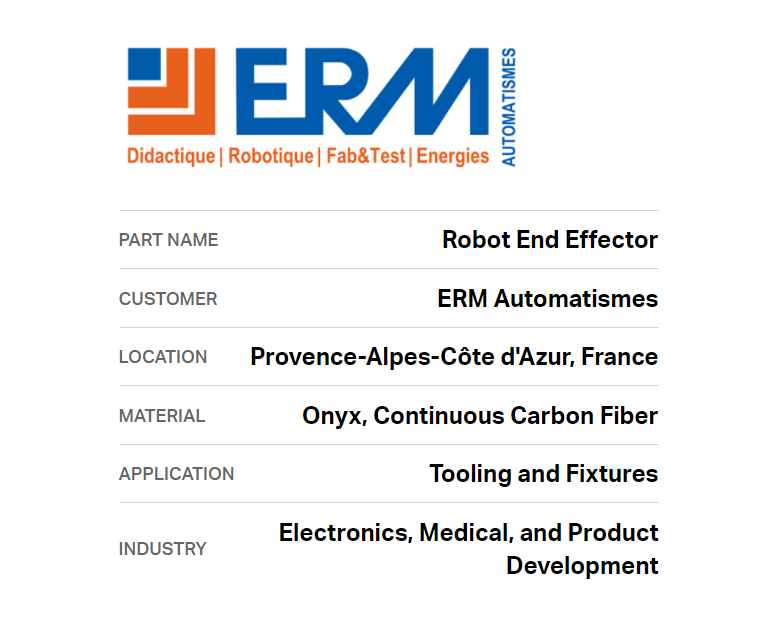
Part Summary:
ERM, a robotics company, has found that their average 3D printed part is 10 times cheaper than its traditionally manufactured counterparts, including highly customized end-of-arm tooling through Markforged. ERM saw a quick return on their investment too; their Composite Printers paid for themselves in just 6 months.
ERM already operated a wide mix of printers, however, none of the machines printed parts strong enough to function in more industrial environments. They decided to acquire both Metal and continuous Carbon Fiber printers to add strong parts to their fabrication.
Full Customer Story:
ERM Automatismes has over thirty years of experience in robotics. They build and integrate robotic systems for both industry and education, which are often customized for very specific applications. This requires them to fabricate a wide variety of bespoke parts. Before investing in the Markforged platform, ERM already owned and operated a wide variety of FDM, SLA, and SLS 3D printers – however, none of the machines printed parts strong enough to function in more industrial environments. They decided to acquire both metal and continuous carbon fiber printers from Markforged to add strong parts to their fabrication capabilities.
ERM has used their Markforged 3D printers to generate value throughout their production facility – they’ve found that the average 3D printed part is ten times cheaper than its traditionally manufactured counterparts. One specific application they’ve found value in is highly customized end-of-arm tooling. Markforged printed parts are strong, reliable, and can integrate with pneumatic systems. ERM has seen immediate return on their investment: their Markforged composite printers paid for themselves in just six months.
About 3D Printing with GSC
There are a variety of ways you can take advantage of 3D printing. Have a question? We’re always available to talk over the phone, for you to leave a message, or for you to submit a request – just contact us.
Please let us know if you would like to:
- Learn more about Markforged and get educational info emailed to your inbox
- Talk over the phone with our Application Engineer to identify possible applications in your line
- Get a sample part of yours printed to prove material strength and ROI (learn more about what makes Metal printing different and what makes Composite printing a plug-and-play replacement for tooling)
Anything you need, we’re here to help!
Share
Meet the Author

